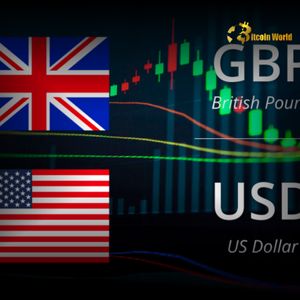BitcoinWorld US Dollar Weakens: Shocking Impact on Forex Markets and British Pound In the ever-volatile world of global finance, currency movements often signal deeper shifts in economic sentiment and geopolitical landscapes. Lately, two major players, the US Dollar and the British Pound , have been under pressure. For those navigating the cryptocurrency space, understanding these macro trends is crucial, as they influence capital flows and investor risk appetite. Let’s delve into the factors causing the US Dollar weakens trend and the concurrent struggles of the British Pound. Why is the US Dollar Weakening? Exploring Key Factors The US Dollar holds significant sway in global trade and finance, often seen as a safe haven. However, recent times have seen it lose some ground against other major currencies. This isn’t happening in a vacuum; several interconnected factors are at play: Trade Uncertainty: A primary driver is persistent trade uncertainty . Ongoing trade disputes, tariff threats, and shifting international trade agreements create instability. This environment makes investors wary of assets tied directly to trade flows, including the US Dollar, which is central to global commerce. Businesses facing unpredictable trade costs may reduce investments, impacting economic outlook and currency strength. Shifting Interest Rate Expectations: Central bank policies, particularly the Federal Reserve’s stance on interest rates, heavily influence the US Dollar. Expectations of potential rate cuts or a pause in rate hikes can make the dollar less attractive to foreign investors seeking yield, compared to currencies where interest rates might be perceived as more favorable or stable. Global Economic Outlook: While the US economy might show pockets of strength, concerns about a potential global slowdown can weigh on the dollar. In times of synchronized global growth, the dollar often benefits from increased trade and investment. Conversely, fears of recession elsewhere can dampen demand for dollar-denominated assets. Fiscal and Political Developments: Domestic policy debates, government spending, and political stability (or lack thereof) can all contribute to currency fluctuations. Large fiscal deficits, for instance, can sometimes put downward pressure on a currency over the long term. Understanding these elements helps paint a clearer picture of why the US Dollar weakens in the current environment. The British Pound’s Plight: A Look at Economic Weakness Across the Atlantic, the British Pound has also faced significant headwinds. Its struggles are often linked to unique domestic challenges, exacerbated by global conditions. The core issue for the British Pound has often been perceived economic weakness within the UK. Post-Brexit Adjustments: The long-term economic impacts of Brexit continue to unfold. Adjustments to new trade relationships with the EU, changes in regulatory alignment, and impacts on labor mobility have created ongoing challenges for various sectors of the UK economy. This structural shift contributes to economic uncertainty and can depress the pound’s value. Inflation and Cost of Living Crisis: Like many countries, the UK has grappled with high inflation. While the Bank of England has raised interest rates to combat this, the resulting cost of living crisis has squeezed consumer spending and potentially dampened economic growth prospects. High inflation erodes purchasing power and can be a sign of underlying economic stress. Productivity Concerns: Economists have pointed to persistent low productivity growth in the UK as a fundamental challenge. Higher productivity is key to sustainable wage growth and overall economic expansion. Struggles in this area contribute to the narrative of economic weakness . Global Headwinds: The UK economy is highly interconnected globally. Slowdowns in major trading partners, supply chain disruptions, and elevated energy prices have all added to the economic pressures faced by the UK, further impacting the British Pound . These factors combine to create a challenging backdrop for the British Pound , leaving it vulnerable to negative news and global risk aversion. Navigating the Forex Market: What Does This Mean? The combined weakness of two major global currencies significantly impacts the broader Forex market . Currency pairs involving USD and GBP (like GBP/USD) become particularly volatile. When the US Dollar weakens against a basket of currencies, it implies other currencies are strengthening relative to it. Similarly, a struggling British Pound means it’s losing value against others. Here’s how this plays out in the Forex market : Increased Volatility: Uncertainty surrounding the economic outlook and trade policies fuels volatility. Traders and investors react quickly to news headlines, economic data releases, and central bank commentary, leading to sharper price swings. Shifting Pair Dynamics: The relative weakness of USD and GBP means that pairs like EUR/USD, USD/JPY, and GBP/EUR experience distinct movements. For example, if the Eurozone economy holds up better, EUR/USD might rise as the US Dollar weakens. If the UK’s economic weakness is more pronounced than the Eurozone’s, GBP/EUR might fall. Impact on Other Assets: Currency movements have ripple effects. A weaker US Dollar can sometimes make dollar-denominated commodities (like oil and gold) cheaper for buyers using other currencies, potentially increasing demand. It can also influence international investment flows and corporate earnings for multinational companies. Staying informed about these dynamics is essential for anyone participating in global markets, including the crypto market, which is increasingly influenced by traditional finance trends. Is Trade Uncertainty the Main Culprit? While many factors contribute to currency movements, the pervasive theme of trade uncertainty stands out as a significant influence on both the US Dollar and the British Pound . Global trade tensions create a difficult environment for planning and investment. Consider these points regarding trade uncertainty : Supply Chain Disruptions: Threats of tariffs or changes in trade relationships can force companies to rethink their supply chains, potentially leading to higher costs or reduced efficiency. This impacts profitability and overall economic health. Reduced Investment: Businesses may postpone or cancel investment decisions when the future of international trade is unclear. This hesitancy slows economic activity. Impact on Exports/Imports: Currency values directly affect the cost of imports and the competitiveness of exports. However, if trade relationships are unstable due to policy uncertainty, the benefits of a weaker currency for exporters might be limited, and the costs of imports might rise regardless of currency moves if tariffs are imposed. Investor Sentiment: Geopolitical tensions and trade disputes often sour investor sentiment, leading to a preference for safer assets, although what constitutes a ‘safe’ asset can also shift depending on the nature of the uncertainty. Sometimes, even traditional safe havens like the dollar can be negatively impacted if the uncertainty directly involves US trade policy. The persistent cloud of trade uncertainty acts as a drag on global growth prospects and contributes significantly to the volatility and weakness observed in currencies like the US Dollar and the British Pound. How Does Economic Weakness Manifest in Currency Values? Perceived or actual economic weakness is directly reflected in a country’s currency value. A weaker economy typically means less attractive investment opportunities, lower potential for interest rate increases (which attract foreign capital), and potentially higher risks. Here’s how economic weakness impacts currencies: Economic Indicator Impact on Currency (Weak Economy) GDP Growth Slow or negative growth reduces investment appeal, weakening currency. Inflation High inflation (if uncontrolled) erodes purchasing power, weakening currency. Low inflation (if deflationary) can signal weak demand, also potentially negative. Unemployment Rate Rising unemployment indicates economic stress, negative for currency. Consumer Spending Falling spending signals weak demand, negative for currency. Trade Balance Persistent large deficits can indicate structural weakness, negative for currency. Government Debt High or rising debt can raise concerns about fiscal stability, negative for currency. When indicators like these point towards economic weakness in the US or the UK, it diminishes confidence in the respective currencies, leading investors to look elsewhere for stronger returns or safer havens. What Are the Actionable Insights for Investors? Given the current environment where the US Dollar weakens and the British Pound struggles amidst trade uncertainty and economic weakness , what should investors, including those in the crypto space, consider? Stay Informed: Keep a close watch on economic data releases from the US and UK, central bank announcements, and developments in international trade negotiations. These are key drivers for the Forex market . Understand Correlations: Recognize that traditional market movements, like currency fluctuations, can impact the crypto market, often influencing overall market sentiment and liquidity. Diversification: Consider the role of currency risk in your portfolio, even if primarily focused on crypto. While crypto is a separate asset class, its value is typically quoted in fiat currencies like USD, meaning its perceived value can be affected by currency strength or weakness. Long-Term Perspective: Currency markets are subject to short-term volatility. For long-term investors, focusing on the fundamental economic health and policy direction of a country is more important than reacting to daily fluctuations. Assess Risk Appetite: Periods of high trade uncertainty and economic weakness can increase overall market risk. Adjust your investment strategy according to your personal risk tolerance. While you might invest directly in crypto, understanding the forces shaping the Forex market provides valuable context for the broader financial ecosystem. In Conclusion: Navigating Choppy Currency Waters The current landscape, marked by a weakening US Dollar and a struggling British Pound , is a clear reflection of the pressures from trade uncertainty and underlying economic weakness . These factors create significant volatility in the Forex market , influencing global capital flows and investor sentiment. For investors, particularly those in the interconnected world of digital assets, recognizing these macroeconomic signals is vital. Currency strength and weakness are not isolated events; they are symptoms of broader economic health and geopolitical stability. By staying informed about the forces impacting major currencies, you gain a deeper understanding of the global financial environment that indirectly shapes the crypto market. The path forward for the US Dollar and the British Pound will depend heavily on how governments and central banks navigate trade relations and address structural economic weakness . Until clearer signals emerge, expect continued volatility in the Forex market . To learn more about the latest Forex market trends, explore our article on key developments shaping US Dollar and British Pound liquidity. This post US Dollar Weakens: Shocking Impact on Forex Markets and British Pound first appeared on BitcoinWorld and is written by Editorial Team



















